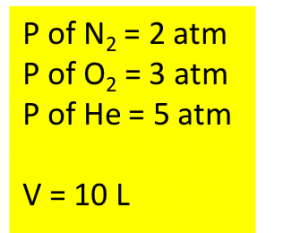This is a 8 point assignment
Objectives: After completing this unit, students should be able to:
- Describe how a barometer and manometer can be used to measure gas pressure.
- Convert among various units of pressure, including torr, atmosphere, mm of Hg, and Pascals.
- Solve problems using Boyle’s law, Charles’ law, the combined gas law, and Avogadro’s Law.
- Solve problems using the ideal gas law.
- Know the value of STP.
- Starting with the ideal gas law, derive a relationship that includes molar mass and gas density and then solve problems using it.
- Using a balanced equation, convert from a given mass, mole, or volume of one gas phase substance to mass, mole, or volume of another.
- Solve problems using Dalton’s Law of Partial Pressures.
- Calculate the mass of a reactant given the volume, total pressure, and temperature of a gas collected over water.
- List and explain the principle points of the kinetic molecular theory of gases and describe the factors responsible for real gases deviating from ideal gases.
- Describe the relationship between temperature, average velocity, and kinetic energy.
- State Graham’s law and use it to solve problems.
- Explain the origin of the correction terms to P and V that appear in the Van der Waal’s equation.
Reading and Homework Exercises
Table of Contents from: OpenStax Chemistry 2e: Chapter 9
Introduction
9.1 Gas Pressure
Questions 1 and 2 check your ability to convert between some common units of pressure and test your understanding of a barometer (which is used to measure ambient atmospheric pressure).
Question 1:
Question 2:
9.2 Relating Pressure, Volume, Amount, and Temperature: The Ideal Gas Law
Questions 3-11 test your understanding of various gas laws and check your ability to solve gas law problems.
Question 3:
Question 4:
Question 5: Answer the following question for the gas phase decomposition of dinitrogen pentoxide:
2 N2O5 –> 2 N2 + 5 O2
Question 6:
Question 7:
Question 8:
Question 9:
Question 10:
Question 11:
9.3 Stoichiometry of Gaseous Substances, Mixtures, and Reactions
Questions 12 and 13 test your understanding of the relationship of the ideal gas law, gas density, and molar mass of a gas and to use these relationships to solve problems
Question 12:
Question 13:
Questions 14 and 15 test your ability to solve stoichiometry problems involving gases
Question 14: Aluminum oxide is decomposed as follows:
2 Al2O3 (s) → 4 Al (s) + 3 O2 (g). Answer the following question given this reaction.
Question 15: Lithium nitride, Li3N, is decomposed as follows:
2 Li3N → 6 Li + N2
Answer the following question:
Questions 16 -20 test your understanding of what happens when gases mix and Dalton’s Law of partial pressure
Question 16:
A tank contains a mixture of three gases (nitrogen, oxygen, and helium), each with the partial pressure as shown in the figure below:

Answer the following two questions (all with the correct number of significant figures) given the above figure:
Question 17:
Question 18:
Question 19:
Question 20:
9.4 Effusion and Diffusion of Gases and
9.5 The Kinetic-Molecular Theory
Questions 21-24 test your understanding of the priciples you have learned about the Kinetic Molecular Theory of gases
Question 21:
A tank contains a mixture of three gases: N2, O2, and He. Answer the following three questions for this mixture:
Question 22:
Question 23:
Question 24:
Questions 25-27 test your understanding of effusion and Graham’s Law
Consider separate 1.0 L gas samples of NH3, H2, CO2, N2O5, CCl4. Answer the following question:
Question 25:
Question 26:
Question 27:
9.6 Non-Ideal Gas Behavior
Questions 25-27 test your understanding of the conditions that make a gas behave more (or less) like an ideal gas.
Question 28:
Question 29:
Question 30:
Gas law can be confusing